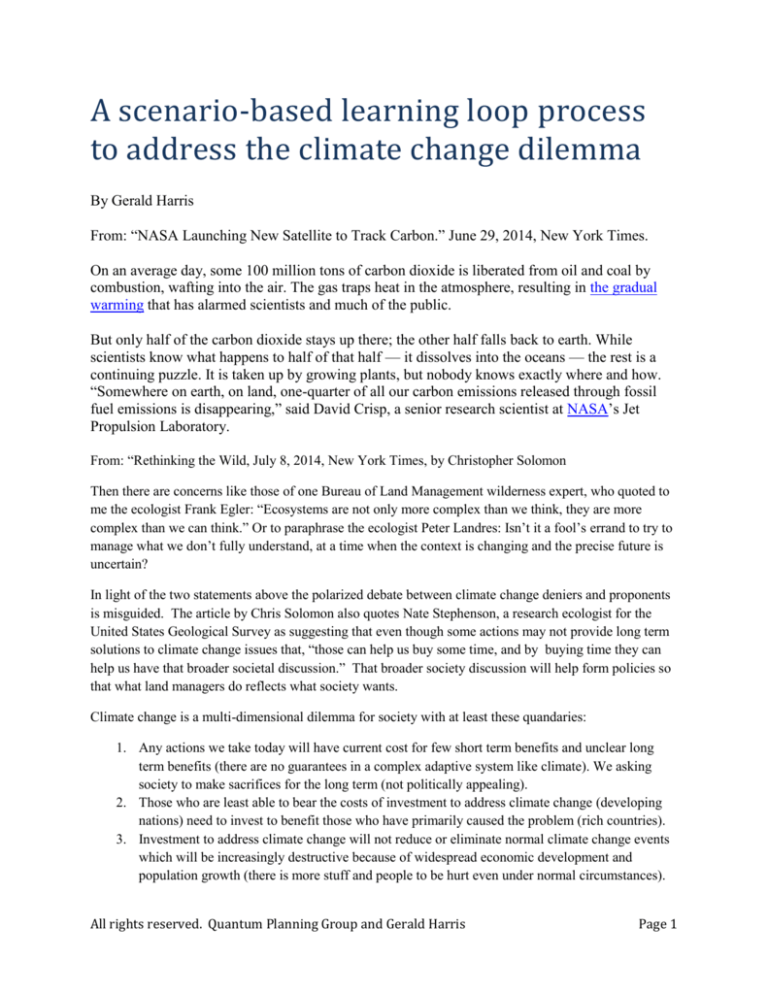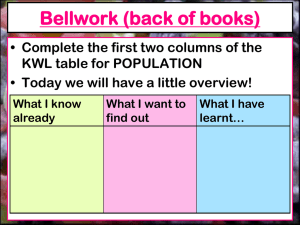
A scenario-based learning loop process
to address the climate change dilemma
By Gerald Harris
From: “NASA Launching New Satellite to Track Carbon.” June 29, 2014, New York Times.
On an average day, some 100 million tons of carbon dioxide is liberated from oil and coal by
combustion, wafting into the air. The gas traps heat in the atmosphere, resulting in the gradual
warming that has alarmed scientists and much of the public.
But only half of the carbon dioxide stays up there; the other half falls back to earth. While
scientists know what happens to half of that half — it dissolves into the oceans — the rest is a
continuing puzzle. It is taken up by growing plants, but nobody knows exactly where and how.
“Somewhere on earth, on land, one-quarter of all our carbon emissions released through fossil
fuel emissions is disappearing,” said David Crisp, a senior research scientist at NASA’s Jet
Propulsion Laboratory.
From: “Rethinking the Wild, July 8, 2014, New York Times, by Christopher Solomon
Then there are concerns like those of one Bureau of Land Management wilderness expert, who quoted to
me the ecologist Frank Egler: “Ecosystems are not only more complex than we think, they are more
complex than we can think.” Or to paraphrase the ecologist Peter Landres: Isn’t it a fool’s errand to try to
manage what we don’t fully understand, at a time when the context is changing and the precise future is
uncertain?
In light of the two statements above the polarized debate between climate change deniers and proponents
is misguided. The article by Chris Solomon also quotes Nate Stephenson, a research ecologist for the
United States Geological Survey as suggesting that even though some actions may not provide long term
solutions to climate change issues that, “those can help us buy some time, and by buying time they can
help us have that broader societal discussion.” That broader society discussion will help form policies so
that what land managers do reflects what society wants.
Climate change is a multi-dimensional dilemma for society with at least these quandaries:
1. Any actions we take today will have current cost for few short term benefits and unclear long
term benefits (there are no guarantees in a complex adaptive system like climate). We asking
society to make sacrifices for the long term (not politically appealing).
2. Those who are least able to bear the costs of investment to address climate change (developing
nations) need to invest to benefit those who have primarily caused the problem (rich countries).
3. Investment to address climate change will not reduce or eliminate normal climate change events
which will be increasingly destructive because of widespread economic development and
population growth (there is more stuff and people to be hurt even under normal circumstances).
All rights reserved. Quantum Planning Group and Gerald Harris
Page 1
Thus there is no basis for an optimal economic assessment to guide investment (for example in
infrastructure). We don’t know how much time we might be buying at what relative cost.
In short addressing climate change has a potential for wasteful (or suboptimal) investments in an
environment where most societies are focused on growth and economic development to extend
production, employment and wealth generation. The long term risk and pay backs are highly uncertain.
Climate change-related investments, unless they support economic growth, will fall to the bottom. In the
rational lingo of finance: using today’s discount rate, the pay offs are too far out into the future with
uncertain cash flows in competition with other investments. There are a limited number of “clean”
investments in energy and other fields (saving water, air quality, etc.) that simultaneously create big
saving or generate lots of revenue that compete with investment like fracking or building coal plants in
China (as evidenced by the much larger amounts being invested in these areas). Even with improving
technology many solar and wind energy investments need tax and other subsidies to pencil out.
In this light, how can society and investors make rational decisions over time to address climate change?
I am suggesting that scenarios be used to address the inherent uncertainty, and that a learning-loop
process associated with the scenarios be used to manage the investment risks. The scenarios can help
answer the questions like:
1. Looking out the next ten to twenty years (an investment cycle for capital intensive industries),
what are the trends we are seeing in climate change and what is the science telling out about the
range and levels of the potential impacts?
2. Looking at the evolving cost and benefits of key investments that will address climate change
(changing in light of technological advancement and regulatory and other policies) which ones
are likely to allow at least a return of capital (lowest threshold).
3. What are the significant risk to investments to address climate change and how might they be
mitigated (via regulation, tax policies, contracts, etc.)?
Shown in Figure 1 is a possible scenario matrix that can be the starting point for creating four different
potential world that might play out over a couple of decades. Technological change and regulatory
policies are suggested as the powerful and highly uncertain drivers that will shape the business
environment or “worlds” of the scenarios and influence investment considerations. Within each scenario
other drivers such as economic factors, customer demands and environmental factors (i.e., evolving
climate change) can be considered under varying conditions. Solid research helps here.
All rights reserved. Quantum Planning Group and Gerald Harris
Page 2
Figure 1
Developed and used properly, the scenarios can be the basis for the societal dialogue suggested by Nate
Stephenson in the NYT. They can also be used to evaluate investments within changing conditions and
risks profiles. An environment governed by conditions like those in the NW of the scenario matrix will
differ significantly from those in the SW quadrant. This framework can also be used longitudinally by
considering movement between quadrants over time (for example from the SW to the NE) as a scenario.
The scenarios thus allow an organized discussion about conditions in the world, expectations and
potential risk factors (changing economic conditions, technology shifts, or customer demands).
Scenarios are most valuable when they are used to make decisions and take actions. However, climate
change investments can be hard to make wisely. This is where embedding a learning loop can be useful.
The core parts of a learning loop are shown in Figure 2.
All rights reserved. Quantum Planning Group and Gerald Harris
Page 3
Figure 2
The scenario process plays a role in the use of a learning loop by grounding the work done is steps 1 and
2 (observing, assessing, and planning for action) in sound analysis. But once actions are taken a clear
process needs to be in place for managing the risks of investing. Though a range of actions can be taken
to manage risks (financial structuring, partnering, guarantees, etc.), learning as events unfold can be
especially powerful because it may surface new opportunities as they arise. Steps 3 and 4 are essential
after investments are made.
In the societal dialogue around such issues as climate change, the learning loop provides a way to talk
about what is known, unknown, and what needs to be learned. It can provide the basis for key stakeholder
engagement.
Here are the steps a company contemplating investing in a clean coal plant with carbon sequestration as
an option might use the processes above:
1. Do an internal assessment of the potential investment so that costs, technological options,
investment conditions, and company appetite for risk are understood.
2. Gather a diverse group of stakeholders to engage in an open way about the investment. This
would include customers, regulators, technical experts as well as management.
All rights reserved. Quantum Planning Group and Gerald Harris
Page 4
3. In a private or semi-public way engage in creating scenarios. Determine how and with whom the
scenarios will be shared.
4. Wind-tunnel or test the clean coal investment within the context of the scenarios to assess
opportunities, risk, cost estimates, potential returns and, option to manage risks.
5. Pursue the investment in light of what was learned in the previous steps and structure the
investment to minimize risks. If carbon sequestration technology is immature and too risky move
to the next best available technology that will not pass muster with laws and regulations. If it
seems risks can be managed by piloting a carbon sequestration technology and guarantees are
given to assure acceptable cost recovery this option might be chosen. If this pilot is chosen, what
information needs to be gathered to learn more and reduce future risks?
6. Identify key stakeholders with which to share the long term learning and reassessments
(regulators, experts, investors, and the public.).
The processes and steps outlined above have places to build in flexibility depending on the conditions
around a specific investment or the company and industry involved (i.e., competitive conditions). Used
wisely, they can move society beyond some of the head-bashing taking place between climate change
deniers and supporters, and toward a real substantive dialogue about solutions.
All rights reserved. Quantum Planning Group and Gerald Harris
Page 5







